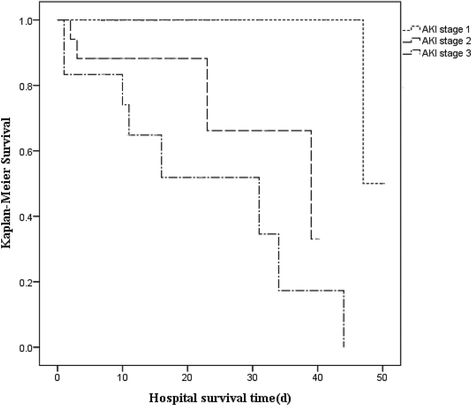The incidence, risk factors and in-hospital mortality of acute kidney injury in patients after abdominal aortic aneurysm repair surgery
- PMID: 28569144
- PMCID: PMC5452373
- DOI: 10.1186/s12882-017-0594-6
The incidence, risk factors and in-hospital mortality of acute kidney injury in patients after abdominal aortic aneurysm repair surgery
Abstract
Background: Acute kidney injury (AKI) is a severe complication associated with abdominal aortic aneurysm (AAA) repair. In this study, we evaluated the incidence, risk factors and in-hospital mortality of AKI in patients after the AAA repair surgery.
Methods: A total of 314 Chinese AAA patients who underwent endovascular aneurysm repair (EVAR) or open aneurysm repair (OPEN) were enrolled in this study. AKI was diagnosed according to the 2012 KDIGO criteria. Logistic regression modeling was used to explore risk factors of AKI, while risk factors associated with in-hospital mortality in AKI patients were investigated using Cox proportional hazards model and Kaplan-Meier analysis, respectively. Multicollinearity analysis was performed to identify the collinearity between the variables before logistic regression analysis and Cox proportional hazards analysis.
Results: Among 314 patients, 94 (29.9%) developed AKI after AAA repair surgery. Severity of AKI and ruptured AAA were independently associated with an increase in in-hospital mortality in AKI patients after AAA repair. Kaplan-Meier analysis identified severity of AKI as being negatively associated with hospital survival in AKI patients. Risk factors associated with AKI included cardiovascular disease (OR 3.169, 95% confidence interval (CI) 1.538 to 6.527, P = 0.002), decreased eGFR (OR 0.965, 95%CI 0.954 to 0.977, P < 0.001), ruptured AAA (OR 2.717, 95%CI 1.320 to 5.592, P = 0.007), renal artery involvement (OR 2.903, 95%CI 1.219 to 6.912, P = 0.016) and OPEN (OR 2.094, 95%CI 1.048 to 4.183, P = 0.036). Further subgroup analysis identified OPEN as an important risk factor of AKI in ruptured AAA patients but not in ruptured AAA patients. The incidence of AKI was significantly lower in EVAR than in OPEN (27.1% vs. 42.8%) and, similarly lower in nonruptured AAA than in ruptured AAA (26.2% vs. 48.1%).
Conclusion: One-third of AAA patients developed AKI after repair surgery. Severity of AKI was associated with reduced survival rate in AAA patients who developed postoperative AKI. Decreased preoperative creatinine clearance, cardiovascular disease, ruptured AAA and OPEN were independent risk factors for postoperative AKI in all 314 AAA patients. Although a lower rate of incident AKI was observed in EVAR compared with OPEN, subgroup analysis of ruptured AAA versus nonruptured AAA showed that EVAR was an independent protective factor for AKI only in ruptured AAA patients but not in nonruptured AAA patients.
Keywords: Abdominal aortic aneurysm; Acute kidney injury; In-hospital mortality; Incidence; Risk factors.
Figures
Similar articles
-
Endovascular Repair of Ruptured Abdominal Aortic Aneurysm Is Associated with Lower Incidence of Post-operative Acute Renal Failure.Ann Vasc Surg. 2016 Aug;35:147-55. doi: 10.1016/j.avsg.2016.01.021. Epub 2016 May 26. Ann Vasc Surg. 2016. PMID: 27236089
-
Incidence of Acute Kidney Injury (AKI) after Endovascular Abdominal Aortic Aneurysm Repair (EVAR) and Impact on Outcome.Eur J Vasc Endovasc Surg. 2015 May;49(5):534-40. doi: 10.1016/j.ejvs.2015.01.002. Epub 2015 Feb 27. Eur J Vasc Endovasc Surg. 2015. PMID: 25736516
-
Incidence and Outcomes of Severe Renal Impairment Following Ruptured Abdominal Aortic Aneurysm Repair.Eur J Vasc Endovasc Surg. 2015 Oct;50(4):443-9. doi: 10.1016/j.ejvs.2015.06.024. Epub 2015 Jul 15. Eur J Vasc Endovasc Surg. 2015. PMID: 26188721
-
Acute Kidney Injury after Open Repair of Intact Abdominal Aortic Aneurysms.Ann Vasc Surg. 2017 Feb;39:294-300. doi: 10.1016/j.avsg.2016.09.010. Epub 2016 Nov 24. Ann Vasc Surg. 2017. PMID: 27890835 Review.
-
Intervention Associated Acute Kidney Injury and Long-Term Cardiovascular Outcomes.Am J Nephrol. 2015;42(4):285-94. doi: 10.1159/000440986. Epub 2015 Oct 24. Am J Nephrol. 2015. PMID: 26495853
Cited by
-
Acute kidney injury after abdominal aortic aneurysm repair: current epidemiology and potential prevention.Int Urol Nephrol. 2018 Feb;50(2):331-337. doi: 10.1007/s11255-017-1767-8. Epub 2017 Dec 11. Int Urol Nephrol. 2018. PMID: 29230707
-
Inflammatory stress in SARS-COV-2 associated Acute Kidney Injury.Int J Biol Sci. 2021 Apr 10;17(6):1497-1506. doi: 10.7150/ijbs.58791. eCollection 2021. Int J Biol Sci. 2021. PMID: 33907513 Free PMC article. Review.
-
Clinical Utility of Urinary Biomarkers for Prediction of Acute Kidney Injury and Chronic Renal Dysfunction After Open Abdominal Aortic Aneurysm Repair.Int J Nephrol Renovasc Dis. 2021 Sep 17;14:371-384. doi: 10.2147/IJNRD.S322916. eCollection 2021. Int J Nephrol Renovasc Dis. 2021. PMID: 34557017 Free PMC article.
-
Modern management of ruptured abdominal aortic aneurysm.Front Cardiovasc Med. 2023 Dec 12;10:1323465. doi: 10.3389/fcvm.2023.1323465. eCollection 2023. Front Cardiovasc Med. 2023. PMID: 38149264 Free PMC article. Review.
-
Association of Neutrophil-Lymphocyte and Platelet-Lymphocyte Ratio with Adverse Events in Endovascular Repair for Abdominal Aortic Aneurysm.J Clin Med. 2021 Mar 5;10(5):1083. doi: 10.3390/jcm10051083. J Clin Med. 2021. PMID: 33807721 Free PMC article.
References
-
- Setacci F, Galzerano G, De Donato G, Benevento D, Guerrieri MW, et al. Abdominal aortic aneurysm. J Cardiovasc Surg. 2016;57:72–85. - PubMed
-
- van Beek SC, Legemate DA, Vahl A, Bouman CS, Vogt L, et al. Acute kidney injury defined according to the ‘Risk’, ‘Injury’, ‘Failure’, ‘Loss’ and ‘End-stage’ (RIFLE) criteria after repair for a ruptured abdominal aortic aneurysm. J Vasc Surg. 2014;60:1159–1167. doi: 10.1016/j.jvs.2014.04.072. - DOI - PubMed
-
- Yue JN, Luo Z, Guo DQ, Xu X, Chen B, et al. Evaluation of acute kidney injury as defined by the risk, injury, failure, loss, and end-stage criteria in critically ill patients undergoing abdominal aortic aneurysm repair. Chin Med J. 2013;126:431–436. - PubMed
MeSH terms
Substances
LinkOut - more resources
Full Text Sources
Other Literature Sources
Medical
Research Materials
Miscellaneous


